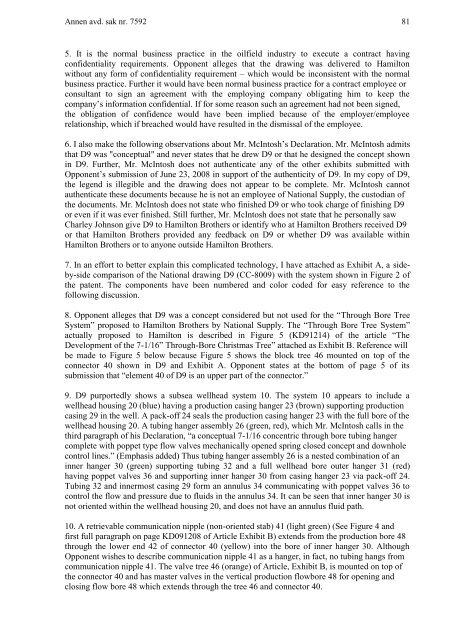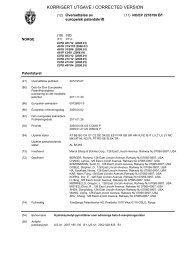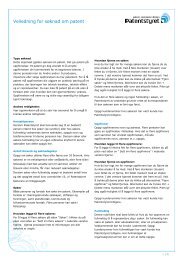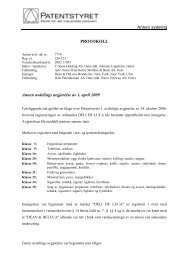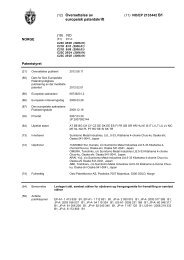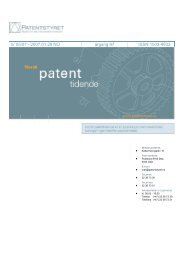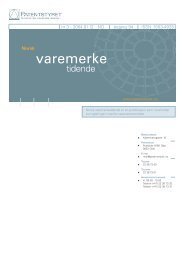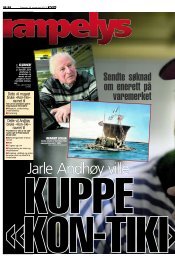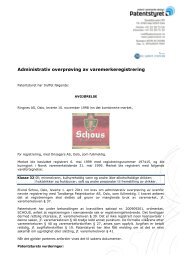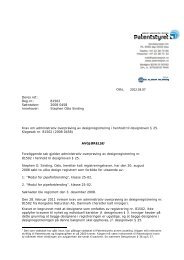Annen avdeling PROTOKOLL Annen avdelings ... - Patentstyret
Annen avdeling PROTOKOLL Annen avdelings ... - Patentstyret
Annen avdeling PROTOKOLL Annen avdelings ... - Patentstyret
Create successful ePaper yourself
Turn your PDF publications into a flip-book with our unique Google optimized e-Paper software.
<strong>Annen</strong> avd. sak nr. 7592 81<br />
5. It is the normal business practice in the oilfield industry to execute a contract having<br />
confidentiality requirements. Opponent alleges that the drawing was delivered to Hamilton<br />
without any form of confidentiality requirement – which would be inconsistent with the normal<br />
business practice. Further it would have been normal business practice for a contract employee or<br />
consultant to sign an agreement with the employing company obligating him to keep the<br />
company‟s information confidential. If for some reason such an agreement had not been signed,<br />
the obligation of confidence would have been implied because of the employer/employee<br />
relationship, which if breached would have resulted in the dismissal of the employee.<br />
6. I also make the following observations about Mr. McIntosh‟s Declaration. Mr. McIntosh admits<br />
that D9 was "conceptual" and never states that he drew D9 or that he designed the concept shown<br />
in D9. Further, Mr. McIntosh does not authenticate any of the other exhibits submitted with<br />
Opponent‟s submission of June 23, 2008 in support of the authenticity of D9. In my copy of D9,<br />
the legend is illegible and the drawing does not appear to be complete. Mr. McIntosh cannot<br />
authenticate these documents because he is not an employee of National Supply, the custodian of<br />
the documents. Mr. McIntosh does not state who finished D9 or who took charge of finishing D9<br />
or even if it was ever finished. Still further, Mr. McIntosh does not state that he personally saw<br />
Charley Johnson give D9 to Hamilton Brothers or identify who at Hamilton Brothers received D9<br />
or that Hamilton Brothers provided any feedback on D9 or whether D9 was available within<br />
Hamilton Brothers or to anyone outside Hamilton Brothers.<br />
7. In an effort to better explain this complicated technology, I have attached as Exhibit A, a sideby-side<br />
comparison of the National drawing D9 (CC-8009) with the system shown in Figure 2 of<br />
the patent. The components have been numbered and color coded for easy reference to the<br />
following discussion.<br />
8. Opponent alleges that D9 was a concept considered but not used for the “Through Bore Tree<br />
System” proposed to Hamilton Brothers by National Supply. The “Through Bore Tree System”<br />
actually proposed to Hamilton is described in Figure 5 (KD91214) of the article “The<br />
Development of the 7-1/16” Through-Bore Christmas Tree” attached as Exhibit B. Reference will<br />
be made to Figure 5 below because Figure 5 shows the block tree 46 mounted on top of the<br />
connector 40 shown in D9 and Exhibit A. Opponent states at the bottom of page 5 of its<br />
submission that “element 40 of D9 is an upper part of the connector.”<br />
9. D9 purportedly shows a subsea wellhead system 10. The system 10 appears to include a<br />
wellhead housing 20 (blue) having a production casing hanger 23 (brown) supporting production<br />
casing 29 in the well. A pack-off 24 seals the production casing hanger 23 with the full bore of the<br />
wellhead housing 20. A tubing hanger assembly 26 (green, red), which Mr. McIntosh calls in the<br />
third paragraph of his Declaration, “a conceptual 7-1/16 concentric through bore tubing hanger<br />
complete with poppet type flow valves mechanically opened spring closed concept and downhole<br />
control lines.” (Emphasis added) Thus tubing hanger assembly 26 is a nested combination of an<br />
inner hanger 30 (green) supporting tubing 32 and a full wellhead bore outer hanger 31 (red)<br />
having poppet valves 36 and supporting inner hanger 30 from casing hanger 23 via pack-off 24.<br />
Tubing 32 and innermost casing 29 form an annulus 34 communicating with poppet valves 36 to<br />
control the flow and pressure due to fluids in the annulus 34. It can be seen that inner hanger 30 is<br />
not oriented within the wellhead housing 20, and does not have an annulus fluid path.<br />
10. A retrievable communication nipple (non-oriented stab) 41 (light green) (See Figure 4 and<br />
first full paragraph on page KD091208 of Article Exhibit B) extends from the production bore 48<br />
through the lower end 42 of connector 40 (yellow) into the bore of inner hanger 30. Although<br />
Opponent wishes to describe communication nipple 41 as a hanger, in fact, no tubing hangs from<br />
communication nipple 41. The valve tree 46 (orange) of Article, Exhibit B, is mounted on top of<br />
the connector 40 and has master valves in the vertical production flowbore 48 for opening and<br />
closing flow bore 48 which extends through the tree 46 and connector 40.


